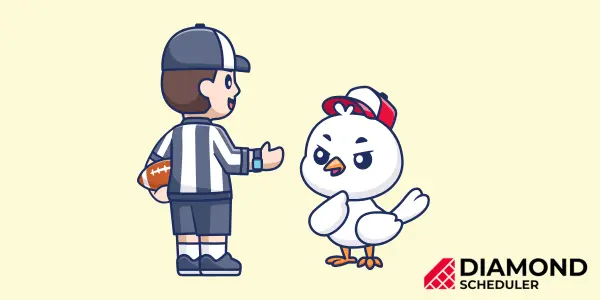
Clocking In: How Long Are College Football Games
College football games are an integral element of American sports culture, enthralling spectators with exhilarating displays of athleticism, strategy, and team spirit. While the popularity of the sport continues to grow, one factor that has received increased attention and caused debate is the length of these games.
The length of college football games has become a hot topic, with supporters and detractors voicing their opinions. As league owners, team managers, and coaches, much can be learned from how college football operates.
Coaches and team managers in junior leagues can prepare their players and staff for what they will encounter might they venture into college sports careers, and league owners can educate themselves on the intricacies of the game when played on such a big platform, especially during the playoffs when elimination tournaments take on the big stage.
Understanding what factors cause college games to have lengthy durations is integral for those that wish to gain experience in a college football coaching or managerial position.
This article will look into the elements that contribute to the different lengths of college football games, providing light on the intricate dynamics that determine the game's duration, from electrifying touchdowns to strategic timeouts.

Factors affecting the length of college football games
If you appreciate the excitement of college football, whether you are a devoted fan, a student-athlete, or simply a casual viewer, you may have observed that not all games are made equally in terms of duration.
While some games go by quickly, others seem to drag on forever. Ever contemplate the reasons why? Small elements, such as changing football equipment during a live game, may slightly increase game length. Even so, let's look at the main elements that affect how long college football games are today.
Halftime break:
A college football halftime is a set time that normally lasts 20 minutes. The timing of when it happens can affect the overall length, even if it is constant across games.
The halftime break gives players and coaches more time to gather and plan a comeback or hold onto the lead if difficulties or a promising lead characterizes the first half.
Game stoppages and reviews:
Stoppages can build up quickly during college football games. The game's rhythm can be disturbed by injuries, penalties, timeouts, and official reviews, which can all result in a lengthy stoppage.
While officials strive for precision in their decisions, several reviews may cause the game to last longer than anticipated.
Television coverage:
Television networks significantly influence the environment of college football. Instant replays, commercial breaks, and analysis are frequently included by networks, which can prolong the game.
For watchers at home, these are necessary, but for stadium spectators, they invariably lengthen the game.
Weather conditions:
Unanticipated weather conditions can also impact a college football game's duration. Temporary suspensions brought on by lightning delays, torrential downpours, or severe temperatures may cause the game to last far longer than expected or be canceled for safety reasons.
Style of play
The teams' playing styles are the biggest element influencing how long the game lasts. The clock keeps ticking, and the game shortens if both sides mostly run the ball.
On the other hand, teams who rely primarily on passing plays tend to stop the clock more frequently, which lengthens games. Games that last longer also tend to be high-scoring, back-and-forth contests with several interruptions.
College football games longest overtime | PSC HighlightsThe average duration of college football games
Despite the lack of precise rules regarding game time, the NCAA and other football governing bodies have made an effort to address the issue because they are worried about the total length of games. For instance, they've put restrictions in place to quicken gameplay and cut down on idle time.
According to NCAA statistics, the average college football game runtime is 3 hours and 22 minutes. Considering that the actual game clock consists of just 60 minutes, that shows just how much extra time is added from other factors.
Strategies to manage game length
In order to strike a balance between offering a thrilling experience for spectators and players while also preserving realistic timetables, managing the length of college football games is crucial. To accomplish this purpose, a variety of tactics can be used:
Encourage continuous play:
Motivate players and coaches to cut down on unnecessary stops during less important parts of the game. This includes running an up-tempo offensive to keep the game moving along or reducing the event when players unnecessarily step out of bounds to stop the clock.
Quick-paced offenses and no-huddle strategies could significantly affect the average game length.
Play clock implementation:
Like in the NFL, a play clock can be utilized in college football to shorten the gap between plays. This promotes game flow and lessens lags brought on by teams taking too long to huddle or prepare for the following play.
Managing injury timeouts:
Football injuries are an unavoidable part of the game, although they occasionally result in extended injury timeouts. The game's duration can be controlled by having medical personnel prepared to respond quickly and which can possibly decrease the number of injury timeouts per team.
Accelerated overtime rules:
The overtime rules in college football have a history of making games last longer. The game's overall length can be controlled by putting in place a system that reduces overtime or changing regulations in the overtime section of a game to manage its length.
Impact on coaches, team managers, and league owners
With the duration of the average college football game increasing over the years, coaches, team managers, and league owners are forced to make modifications to how they bracket and schedule games, practices, and other events.
League owners must also keep in mind the television contract obligations and broadcasting schedules that could be affected by potential game duration changes.
Time management for practice and preparation
Time management skills are essential for everyone involved in college football's success and welfare. For student-athletes to be successful on and off the field, they must balance their athletic endeavors and academic obligations.
Coaches and administrators must make sure they create an atmosphere that fosters student-athletes academic growth while achieving athletic success.
Television contracts and revenue generation
Overall, both college football programs and television networks benefit from television contracts. The networks secure quality programming that draws viewers and advertisers, ultimately driving their own revenue and ratings, while the programs receive financial backing and improved visibility.
College football and the conferences to which they belong receive a sizable portion of their funding from television deals. The broadcasting rights to college football games are purchased by television networks for a hefty sum of money.
These agreements permit networks to broadcast games on their channels, giving them access to compelling programming that pulls in big audiences, especially for highly anticipated matchups and prestigious teams.

Fan perspectives on game length
Long college football games seem to have fans divided on the topic. A longer game may be more entertaining for certain fans, as it gives them more time to see their favorite team play, wear their team's logos and colors longer, and experience more opportunities to view exciting plays and comebacks.
Longer games can also make spectators feel as if they got their money's worth, whether they go in person or spend a lot of time watching on television. However, some fans may find extended games to be boring or inconvenient.
Longer games could tire out spectators who come in person or stay up late to watch the whole thing on TV. Long games can also conflict with other obligations or plans, especially for physically present individuals who may have to make travel arrangements.
Incomplete passes, replay reviews, and commercial breaks can all increase the length of the game, but the main factor in increasing game time is how college football has evolved into a more pass-oriented game.
Looking at the longest football game ever played | KTOProposed changes and innovations
While some might argue that even though college football games are longer than they ever have been before, they're also jam-packed with more scoring and exciting sequences because of the gameplay.
Nevertheless, reducing the duration of college games through various changes could help make them more engaging for players, fans, and broadcasters. Here are some suggested adjustments that could potentially shorten college games:
Shorter halftimes: Change the customary 20-minute halftime to a 15-minute break. This adjustment may aid in keeping the game moving along and viewers interested.
Fewer TV timeouts: Reduce the number and length of commercial breaks in cooperation with broadcasters. Reduce the frequency of TV timeouts and look for different ways to incorporate commercials into the game without interfering with it.
Time limits on replay reviews: Put a time limit on how long referees can review contentious calls. The call on the field stands if they cannot reach a consensus in the allotted amount of time (for example, 90 seconds). This will aid in avoiding unneeded delays throughout the game.
Running the clock after first downs: Similar to the NFL's regulations, in some circumstances, the clock may continue to tick after a first down. This would speed up play and cut down on overall game time.
Shorter play clock: Making the play clock 30 or 35 seconds instead of 40 seconds could encourage quicker offensive play and shorten the time between plays.
No overtime kickoff: In overtime, begin possessions without a kickoff from the opponent's 25-yard line. This can save time by removing the need for extra kickoffs and breaks.
Strategic timeouts: To prevent excessive stoppages, limit the amount of timeouts teams can call during particular parts of the game, such as the last few minutes of each quarter.
Reduce game length for blowouts: Implement a running clock to speed up the game if a team has a sizable advantage (35 points or more) in the fourth quarter.
Encourage quicker huddles: It is possible to shorten the length of huddles and maintain a faster pace between plays by encouraging coaches and players to do so.
It should be noted that these proposed improvements may have various effects on the game and may necessitate careful evaluation and testing prior to deployment. The goal should be to establish a balance between lowering game time and keeping college football's integrity and enthusiasm.
Balancing game length and tradition
Balancing college game length and tradition is a challenging task that requires considering various elements such as fan expectations, player welfare, economic interests, and the overall experience for everyone involved.
While many of college football's traditions are fan-oriented and exist outside the actual gameplay, like tailgates and bands, changes to the rules to improve game flow may not have a negative impact on the fan's perspective.
Determining which are crucial to the college athletics experience and have historical and cultural significance would be helpful. Finding a careful balance between game length and current demands is critical in the ever-changing world of college football to ensure the sport stays dynamic and relevant.
Traditional college football games have long been loved for their illustrious histories and deeply ingrained traditions, which capture the heart of school pride and community enthusiasm.
However, in today's fast-paced world, with many entertainment options and shorter attention spans, there is an increasing need to adapt the game to fit current needs.
To achieve this balance, players' well-being, fan involvement, economic interests, and TV viewership must all be carefully considered.
FAQs
With the duration of the average college football game increasing over the years, league owners should consider factors that lengthen a game’s duration and add modifications to manage or shorten the length of a game.
How long do college football games normally last?
A college football game's length, on average, lasts about 3.5 hours.
How many hours is the longest college football game?
The longest college football game recorded was Arkansas vs. Kentucky which took place on November 1, 2003. The match lasted for 4 hours, 56 minutes, and the final score was 71 Arkansas, 63 Kentucky.
Why do college football games take longer than NFL?
Over the years, college football games have gotten longer and longer, frustrating both players and fans. The length of these games is affected by a number of things, such as the clock, replay reviews, commercial breaks, TV timeouts, and halftime.
Recap
A variety of factors influence the length of college football games, including gameplay, strategy, the number of quarters, the duration of halftime breaks, time-outs, scheduled commercial breaks, instant replay reviews, player injuries, and more.
In today's fast-paced world, finding a balance between these aspects is critical to ensuring an entertaining and thrilling game while honoring player welfare, business interests, and fan and viewer expectations.
A balanced view on college football game length must take into account the influence on all stakeholders. The sport can develop sustainably while maintaining its essence and appealing to a varied and passionate audience by considering the requirements and viewpoints of players, fans, institutions, broadcasters, and other participants.
There's no doubt these decisions are difficult and time-consuming. Developing a strategic approach to tackle the topic of prolonged college football games takes a dedicated team of league owners, coaches, and broadcasting partners.
With the help of scheduling software like Diamond Scheduler, more time can be allocated to this issue by optimizing operations within the scheduling process.
With powerful automation and constraint implementation, Diamond Scheduler makes building that complex season and team management easier than ever before!
Jeff Tipper is an avid sports fan who has a strong passion for basketball. A graduate of the University of New Mexico with a Bachelor's Degree in Operations Management, Jeff has experience in operations and claim processing and spends his free time writing articles and blogs focused on sports and various business topics.
About Diamond Scheduler
Diamond Scheduler makes planning your league’s complex season easier than ever. Create your first schedule in minutes for free. It's fast, fun, and simple.



